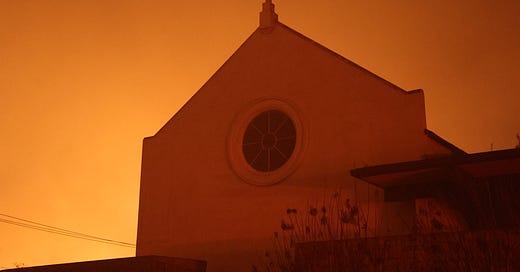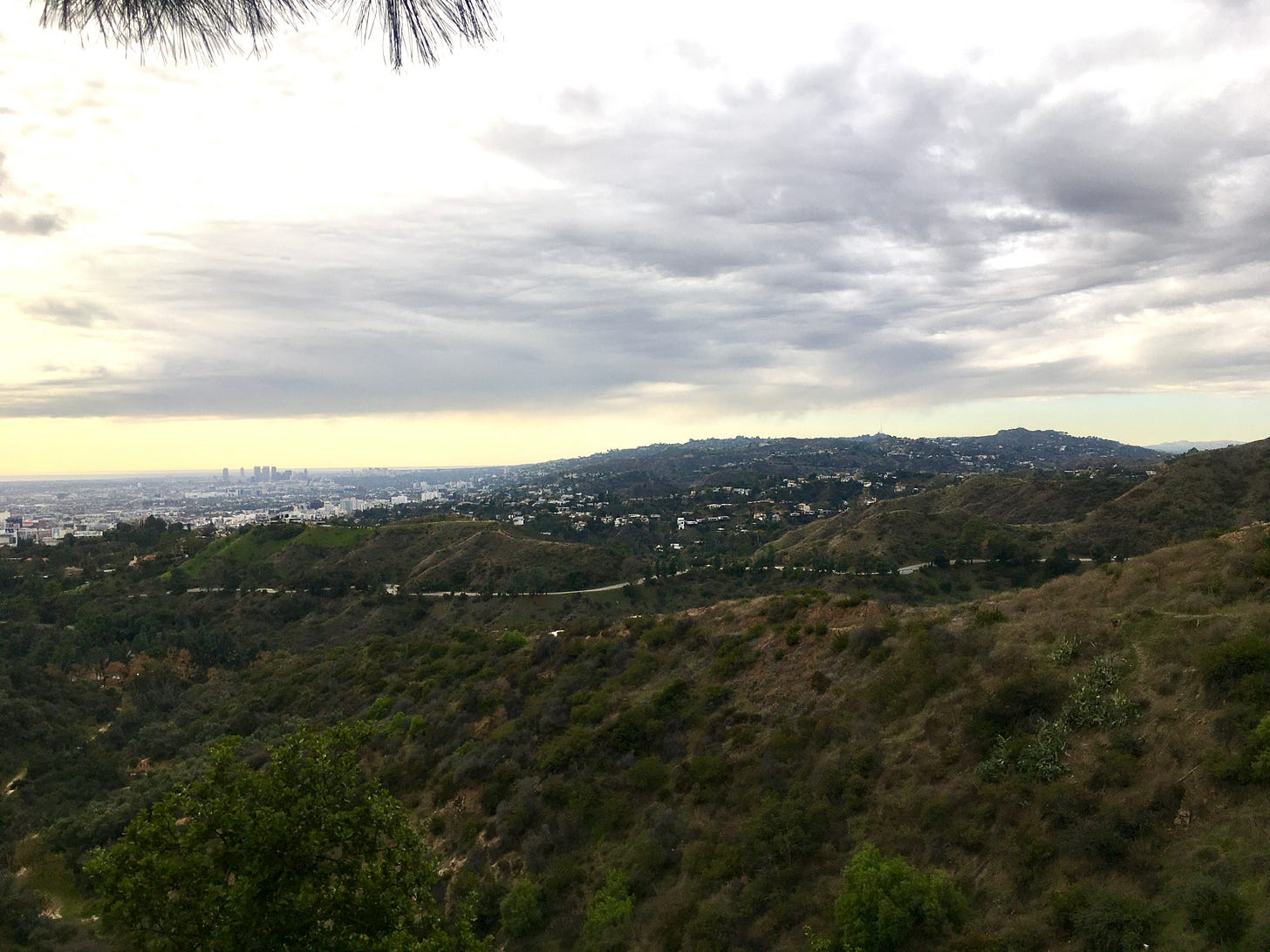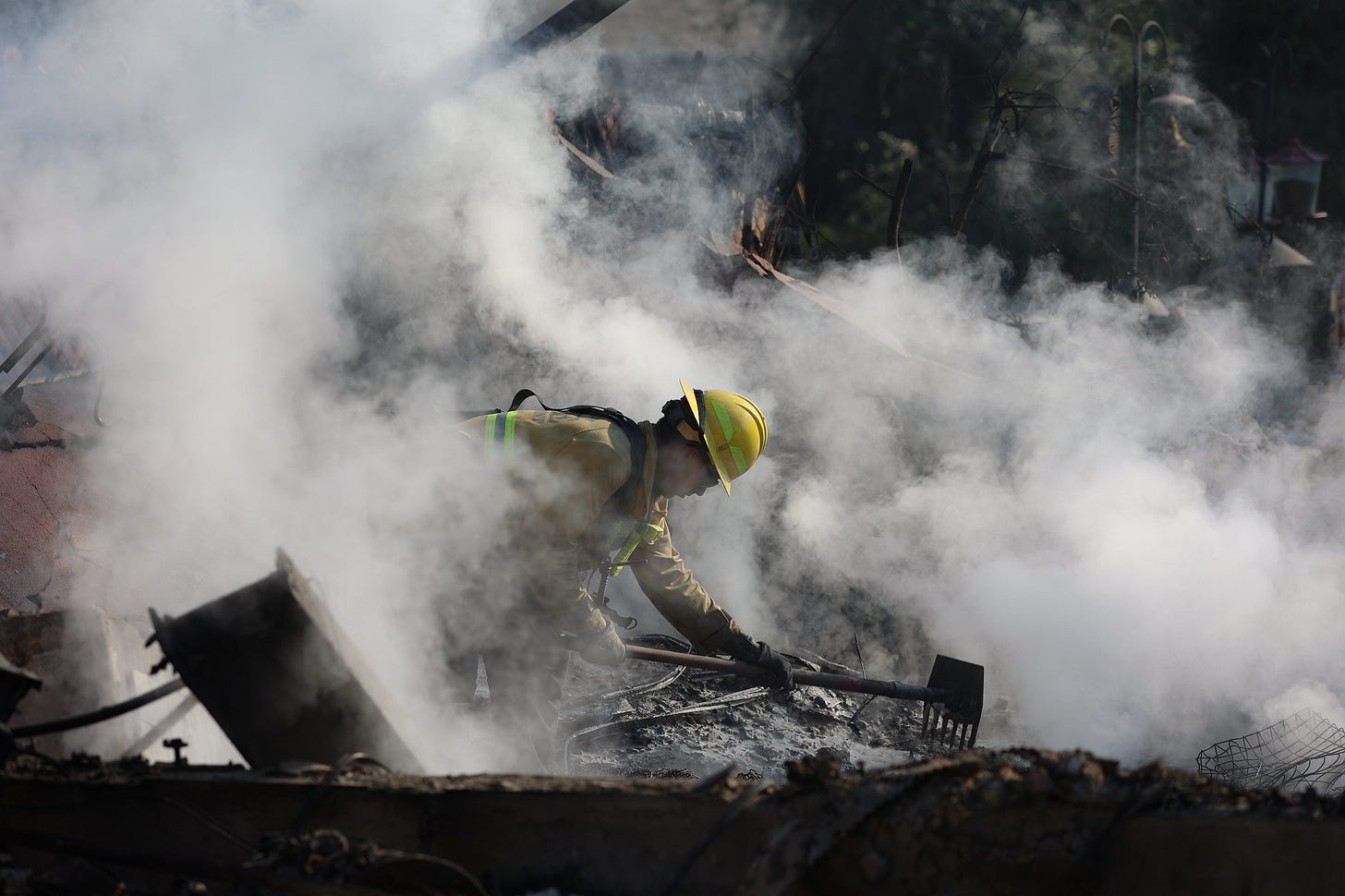So apocalyptic it’s unreal
On wind, the “lethal mixture of homeowners and brush,” the development of Malibu, preparedness measures, rebuilding, and more.
Earlier this week I texted a friend who moved to Los Angeles at the end of last year to make sure she was out of harm’s way from the wildfire burning to the west of her new apartment. She reported that she was currently in the clear and people were going about their business as usual, although the winds were monstrous. A day or two later, with new fires burning to the north and to the east, she had a go-bag packed, just in case her neighborhood was ordered to evacuate. She said she was reading up on the folklore around the Santa Ana winds, and sent me a link to the canonical Joan Didion essay.
Apparently, even National Review contributors read Didion “When California burns.” I try to imagine myself regurgitating Didion to make some thin, trite point about Californian optimism right now, and fail.
I followed the wildfires closely this week, because people I know and care about are in LA; because of my work; and because they are so extraordinarily horrifying, tragic, and shocking—even if, in hindsight, they weren’t completely unpredictable or surprising. Yet despite monitoring of social media, newspaper live feeds, and the occasional press conference, the disaster is so enormous, it’s been hard to absorb or to fully comprehend, especially from a distance. It’s so apocalyptic it’s unreal.
Unfortunately, it seems that even some Angelenos have struggled to grasp the reality of the situation, or to expand their circle of concern and empathy beyond their own personal bubble. For example, New York Times reporter Isabelle Taft interviewed one man who had stayed behind in his home—within an evacuation zone—and was still expecting an Amazon Fresh delivery.
I read “The Case for Letting Malibu Burn,” an excerpt of Mike Davis’ 1998 book, Ecology of Fear: Los Angeles and the Imagination of Disaster, which finds perennial relevance. It was excerpted by Longreads and given a postscript after the 2018 Camp Fire razed Paradise, California. He writes compellingly of the “lethal mixture of homeowners and brush.” Regarding the devastating wildfires that semi-regularly sweep through Malibu, Davis wrote (in 1998), “Since 1970 five such holocausts have destroyed more than one thousand luxury residences and inflicted more than $1 billion in property damage.”
As of midday Saturday, experts estimate more than 12,000 structures (which includes cars and sheds as well as single-family homes and sprawling mansions) have been destroyed by the infernos in Los Angeles, and damages could be between $135 and $150 billion. At least 16 people have died.
Of particular interest in the Davis excerpt to me, and possibly to Pinch of Dirt readers, was the story of how Frederick Law Olmsted, Jr. tried and failed to make Malibu a publicly-owned haven:
In hindsight, the 1930 fire should have provoked a historic debate on the wisdom of opening Malibu to further development. Only a few months before the disaster, Frederick Law Olmsted, Jr.—the nation’s foremost landscape architect and designer of the California state park system—had come out in favor of public ownership of at least 10,000 acres of the most scenic beach and mountain areas between Topanga and Point Dume. Despite a further series of fires in 1935, 1936, and 1938 which destroyed almost four hundred homes in Malibu and Topanga Canyon, public officials stubbornly disregarded the wisdom of Olmsted’s proposal for a great public domain in the Santa Monicas. The county of Los Angeles, for example, squandered an extraordinary opportunity in 1938 to acquire 17,000 acres of the bankrupt Rindge estate in exchange for $1.1 million in delinquent taxes. At a mere $64 per acre, it would have been the deal of the century.
I have been senselessly frustrated at those who have pointed to Didion and Davis or just to the historical fact of fires in southern California to discount the role or existence of climate change. (See, for example, some of the comments on that National Review blog post.) Senselessly because there is no point, and because it makes me tongue-tied by abject horror and rage.
SHE WROTE THIS IN THE 1960s?? I THOUGHT THIS WAS BECAUSE OF ‘CLIMATE CHANGE.’ CALIFORNIA HAS ALWAYS BURNED.
…glibly ignoring the fact that “Late August to early October is the infernal season in Los Angeles” (Davis). Not January. Demonstrating an obstinate refusal to hold two or more truths or facts in one’s mind at the same time.
If you can stand it, see also: Fox News, The Telegraph. I don’t recommend it though.
Of course mistakes were made. There will surely be plenty of blame to mete out over the coming days, weeks, months. But any issues or problems around land use or management doesn’t negate the influence of climate change, I want to scream into my pillow.
By nightfall Tuesday, watching local news feeds of eucalyptus trees immolating into showers of sparks as residents with belongings strapped onto bike frames raced past charred cars, the number of people I knew who were evacuating doubled, tripled, quadrupled. Then, a new tally began: the number of friends who have lost their homes. —Alissa Walker, Torched
Alissa Walker, a writer who covers public space and urban issues in Los Angeles, wrote a dispatch from Los Angeles. It is full of all the life and detail and context and vibrancy that the cold, distant (but still helpful!) New York Times live coverage is missing.
(I know—why am I reading about a California disaster in a New York paper? Habits are hard to break.)
The politics of California, and especially of Los Angeles, are virtually unknown to me, but Walker’s post helped me understand a bit more of the local tensions and sore spots around the fire response.
A damning detail: “The city’s first press release detailing ‘preparedness measures ahead of anticipated dangerous windstorm’ went out Tuesday at 10:56 a.m. — after the Palisades Fire had started.”
We went to a movie last night, a Hollywood/California/L.A. movie (sorta) (Inland Empire). I’m finishing this post up after we got back home (it’s 2am) so excuse my rambling, and any typos (my editor is already abed).
It was experimental and fragmented and very long. Without the scaffolding of a strong plot, my mind wandered more than usual. One of my rambling trains of thought took me to the California hills and the beaches and the oh-so-understandable desire to live amongst the trees and the grasses, under the sun, beneath the winds. I thought about how Biden, in the dying gasp of his presidency, pledged to help the area recover and rebuild, and how silly and dangerous it will be if people rebuild just like before.
But it would also be so human, so normal, and basically exactly what’s happened every other time there was a fire out there, it seems. Nobody wants to be told they can’t be made whole, that they can’t go back home and rebuild. Humans are so frail and so stupid. They want things they maybe shouldn’t have. And my heart breaks for the ones who have been hurt most by these terrible fires, which are still burning.







I keep thinking of the wildlife affected by the fires. So dreadfully sad and disturbing. Running for their lives if they can.
Apocalyptic is a good word for it. I've been watching the coverage of fires in LA, where I grew up, from my current home where we are recovering from Hurricane Helene. The magnitude of devastation drives home that there's no escaping climate change. I do think that improved land use policies and preparedness will be key to minimizing loss of homes and of human life in future disasters.